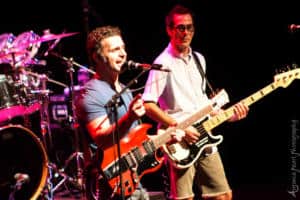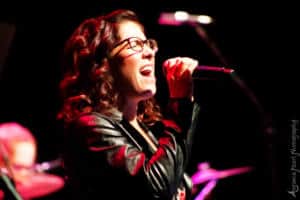Dweezil Zappa – Bruce Mason Centre February 20, 2018
Legacy is a weighty word, but Dweezil Zappa managed to carry it lightly. Playing “Whatever the F@&# He Wants,” as the tour heading proclaimed, what Zappa wanted to play was a near three-hour tour of his father, Frank Zappa‘s decades-long career.
An icon of 60s and 70s counter-culture, Frank Zappa still has an obsessive cult following, his name still spoken with deep respect by musicians. His work represents the wild creativity, musical accomplishment and transgression of the psychedelic and progressive genres, without stagnating into the self-serious wankery that became rife as they went on.
The gathering at the Bruce Mason Centre was all about the celebration of that work. The stage set up was sparse, a simple layout of instruments and non-intrusive lighting flourishes. The crowd that filed into the intimate theatre was weighted heavily to the middle-aged and male, but also spread across gender and age all the way down to some scattered early twenty somethings, who seemed as rapt to be there as anyone else. The band took the stage with little fanfare but warm applause, simply strolling on-stage and taking up their instruments, Dweezil Zappa making a short, casual introduction before starting the first song with an exuberant little bunny hop.

Man, what sweet music it was, too. I’m best described as a casual Zappa fan, an uncommon thing to an artist usually either ignored or obsessed over. While I didn’t have the years of familiarity with the albums that a lot of the audience did, I almost felt that was a privilege, as a lot of these songs I was experiencing for the first time. I can say that they hold their freshness, their ability to startle, entertain, amuse and even to awe. The sheer density of ideas packed into the compositions remains impressive to this day. The musical influences were clear, from jazz, blues and rock and roll to soul, doo-wop and even surf pop. There was no hint of the derivative though: the musical starting points were always meddled with, altered, parodied or combined with each other in such a way that there was no way to predict the next moment.
This added to the impressive musicianship of the band, as they veered note-perfect through abrupt side passages, frenetic bursts of off kilter musical phrases, and near imperceptible transitions. Zappa’s guitar predictably often took centre stage, displaying some mesmerising fretwork. This was far from a one man show with a backing band, however. The talent and character of each member shone through every song, and most got a few individual moments of glory. Of particular note was lead vocalist Cian Coey, who showed off her power and versatility across various styles from a smoky rock bellow to a soulful murmur. Scheila Gonzalez easily played the widest variety of instruments across the night, from keys to a lovely sax solo to, improbably, a duck whistle. I especially loved the synchronised riff held between Gonzalez on the flute, Zappa’s guitar, and Chris Norton’s keys.

The tongue in cheek eccentricity of the recordings was mostly converted directly into live performance, with spoken word passages being performed by various members of the band, sometimes all at once in trippy cacophony. Away from the mic, they danced over their instruments as they played, grinning broadly, interacting wordlessly with each other. They made playing this challenging music look like the most fun thing in the world, and the mood was infectious to the audience. Cheering boisterously at every song, throwing out good natured heckles and song requests, there was a direct sense of camaraderie between the people in the seats and those on stage. Zappa maintained that sense between songs with casual, conversational crowd interaction, introducing songs and responding gracefully to those audience calls he could hear clearly. “This is when my Dad was pretending to be a hippie,” he said of one monologue, “when he never was a hippie really, he more made fun of them.” “Blasphemy,” cried the very hippie looking older gent a few seats down from me, perhaps attempting a recreation of Bob Dylan’s “Judas!” moment.

I forced myself to leave at the close of the main set, as Zappa and the band bowed to a rapturous standing ovation. I knew there was a triumphant, and probably lengthy, encore on the way, but sadly I wasn’t prepared to risk the last bus out of Papakura, having been burned by Auckland Transport before. Even with cutting it a bit short, however, Dweezil Zappa’s show had been packed with a density of talent, entertainment and weirdness that’s going to prove hard to forget.
Cameron Miller
- Civil War – Dir: Alex Garland (Film Review) - April 9, 2024
- Pearl Jam – Dark Matter (Monkeywrench/Republic) Album Review - April 1, 2024
- Blonde Redhead – New Zealand Tour 2024 - March 14, 2024
